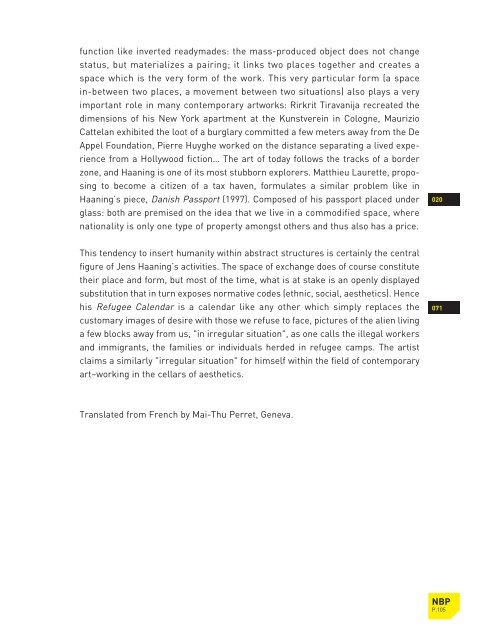download catalogue high resolution pdf (22.3 mb) - Jens Haaning
download catalogue high resolution pdf (22.3 mb) - Jens Haaning
download catalogue high resolution pdf (22.3 mb) - Jens Haaning
Create successful ePaper yourself
Turn your PDF publications into a flip-book with our unique Google optimized e-Paper software.
function like inverted readymades: the mass-produced object does not change<br />
status, but materializes a pairing; it links two places together and creates a<br />
space which is the very form of the work. This very particular form (a space<br />
in-between two places, a movement between two situations) also plays a very<br />
important role in many contemporary artworks: Rirkrit Tiravanija recreated the<br />
dimensions of his New York apartment at the Kunstverein in Cologne, Maurizio<br />
Cattelan exhibited the loot of a burglary committed a few meters away from the De<br />
Appel Foundation, Pierre Huyghe worked on the distance separating a lived experience<br />
from a Hollywood fiction… The art of today follows the tracks of a border<br />
zone, and <strong>Haaning</strong> is one of its most stubborn explorers. Matthieu Laurette, proposing<br />
to become a citizen of a tax haven, formulates a similar problem like in<br />
<strong>Haaning</strong>’s piece, Danish Passport (1997). Composed of his passport placed under<br />
glass: both are premised on the idea that we live in a commodified space, where<br />
nationality is only one type of property amongst others and thus also has a price.<br />
This tendency to insert humanity within abstract structures is certainly the central<br />
figure of <strong>Jens</strong> <strong>Haaning</strong>’s activities. The space of exchange does of course constitute<br />
their place and form, but most of the time, what is at stake is an openly displayed<br />
substitution that in turn exposes normative codes (ethnic, social, aesthetics). Hence<br />
his Refugee Calendar is a calendar like any other which simply replaces the<br />
customary images of desire with those we refuse to face, pictures of the alien living<br />
a few blocks away from us, "in irregular situation", as one calls the illegal workers<br />
and immigrants, the families or individuals herded in refugee camps. The artist<br />
claims a similarly "irregular situation" for himself within the field of contemporary<br />
art–working in the cellars of aesthetics.<br />
Translated from French by Mai-Thu Perret, Geneva.<br />
020<br />
071<br />
NBP<br />
P.105


